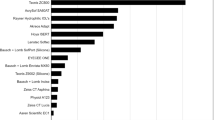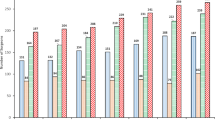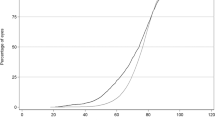Abstract
Background
A sudden, irreversible reduction in visual acuity (‘wipe-out’) is a feared complication of cataract surgery. Current literature on wipe-out is limited in quantity and quality, and largely predates modern cataract surgery and imaging techniques. The objectives of our study were to estimate the incidence of wipe-out and to identify potential risk factors.
Methods
We prospectively collated cases of wipe-out occurring in the UK during a 25-month study period using the British Ophthalmic Surveillance Unit reporting system. A total of 21 potential cases of wipe-out were reported, 5 of which met all inclusion and exclusion criteria.
Results
The estimated incidence of wipe-out during the study period was 0.00000298, or approximately 3 cases per million cataract operations. All cases of wipe-out occurred exclusively in patients with advanced glaucoma (mean deviation −21.0 decibels or worse in the operated eye), with an over-representation of black people (40%) in our case series. A prior diagnosis of retinal vein occlusion (60%) and elevated post-operative IOP (40%) were more common among individuals suffering from wipe-out compared to the general population, suggesting these factors may contribute to the pathogenesis of wipe-out.
Conclusions
Our study shows that wipe-out is a rare complication, affecting approximately 3 per million undergoing cataract surgery. Patients with advanced glaucoma, black patients, and those with previous retinal vein occlusions may be at greater risk of wipe-out. We hope that the findings of our study will be used to help inform treatment decision-making and the cataract surgery consent process.
This is a preview of subscription content, access via your institution
Access options
Subscribe to this journal
Receive 18 print issues and online access
$259.00 per year
only $14.39 per issue
Buy this article
- Purchase on Springer Link
- Instant access to full article PDF
Prices may be subject to local taxes which are calculated during checkout
Similar content being viewed by others
References
Sharma N, Ooi J-L, Francis IC, Sharma S, Papalkar D, Kim P, et al. Sudden visual loss after uneventful cataract surgery: Snuff syndrome. J Cataract Refract Surg. 2004;30:2435–7.
GBD 2019 Blindness and Vision Impairment Collaborators, Vision Loss Expert Group of the Global Burden of Disease Study. Causes of blindness and vision impairment in 2020 and trends over 30 years, and prevalence of avoidable blindness in relation to VISION 2020: the Right to Sight: an analysis for the Global Burden of Disease Study. Lancet Glob Health. 2021;9:e144–60.
Rahman F, Zekite A, Bunce C, Jayaram H, Flanagan D. Recent trends in vision impairment certifications in England and Wales. Eye. 2020;34:1271–8.
AGIS (Advanced Glaucoma Intervention Study) Investigators. The Advanced Glaucoma Intervention Study: 8. Risk of cataract formation after trabeculectomy. Arc Opthamol. 2001;119:1771–9.
Musch DC, Gillespie BW, Niziol LM, Janz NK, Wren PA, Rockwood EJ, et al. Cataract extraction in the collaborative initial glaucoma treatment study: incidence, risk factors, and the effect of cataract progression and extraction on clinical and quality-of-life outcomes. Arch Ophthalmol. 2006;124:1694–700.
Deva NC, Insull E, Gamble G, Danesh-Meyer HV. Risk factors for first presentation of glaucoma with significant visual field loss. Clin Exp Ophthalmol. 2008:36:217–21.
Ng WS, Agarwal PK, Sidiki S, McKay L, Townend J, Azuara-Blanco A. The effect of socio-economic deprivation on severity of glaucoma at presentation. Br J Ophthalmol. 2010;94:85–7.
Graefe von A. Beiträge zur Pathologie und Therapie des Glaucoms. Arch Opthalmol. 1869;15:108–252.
Kolker A. Visual prognosis in advanced glaucoma: a comparison of medical and surgical therapy for retention of vision in 101 eyes with advanced glaucoma. Trans Am Ophthalmol Soc. 1977;75:539
O’Connell EJ, Karseras AG. Intraocular surgery in advanced glaucoma. Br J Ophthalmol. 1976;60:124–31
Aggarwal SP, Hendeles S. Risk of sudden visual loss following trabeculectomy in advanced primary open-angle glaucoma. Br J Ophthalmol. 1986;70:97–9.
Levene RZ. Central visual field, visual acuity, and sudden visual loss after glaucoma surgery. Ophthalmic Surg. 1992;23:388–94.
Moster MR, Moster ML. Wipe-out: a complication of glaucoma surgery or just a blast from the past?. Am J Ophthalmol. 2005;140:705–6.
Altmeyer M, Wirbelauer C, Häberle H, Pham D. Katarakt-Operation bei Patienten mit Glaucoma fere absolutum. Klin Monatsbl Augenheilkd. 2006;223:297–302.
Law SK, Nguyen AM, Coleman AL, Caprioli J. Severe loss of central vision in patients with advanced glaucoma undergoing trabeculectomy. Arch Ophthalmol. 2007;125:1044–50.
Foot B, Stanford M, Rahi J, Thompson J. British Ophthalmological Surveillance Unit Steering Committee. The British Ophthalmological Surveillance Unit: an evaluation of the first 3 years. Eye (London, England). Eye. 2003;17:9–15. Jan
Eurostat. Eurostat - Data Explorer. 2022. http://appsso.eurostat.ec.europa.eu/nui/submitViewTableAction.do.
Zhang N, Wang J, Li Y, Jiang B. Prevalence of primary open angle glaucoma in the last 20 years: a meta-analysis and systematic review. Sci Rep. 2021;11:1–12.
Keel S, Xie J, Foreman J, van Wijngaarden P, Taylor HR, Dirani M. Prevalence of retinal vein occlusion in the Australian National Eye Health Survey. Clin Exp Ophthalmol. 2018;46:260–5.
Grzybowski A, Kanclerz P Do we need day-1 postoperative follow-up after cataract surgery? Arch Opthalmol. 2019;257:855–61.
Cultural identity - Office for National Statistics. 2022. https://www.ons.gov.uk/peoplepopulationandcommunity/culturalidentity.
Martin MJ, Sommer A, Gold EB, Diamond EL. Race and primary open-angle glaucoma. American Journal of Ophthalmology. Am J Ophthalmol. 1985;99:383–7.
Wild S, Roglic G, Green A, Sicree R, King H Global prevalence of diabetes: estimates for the year 2000 and projections for 2030. Diabetes Care 2004;27:1047–53.
Donachie PH, Sparrow JM. NOD audit annual reports - resources - NOD - National Ophthalmology Database Audit. 2017. nodaudit.org.uk.
Tapela N, Collister J, Clifton L, Turnbull I, Rahimi K, Hunter DJ. Prevalence and determinants of hypertension control among almost 100 000 treated adults in the UK. Open Heart. Arch Dis Child. 2021;8:e001461.
Friedman D, O’Colmain B, Munoz B, Tomany S, McCarty C, de Jong PTVM, et al. Prevalence of age-related macular degeneration in the United States. Arch Ophthalmol. 2004;122:564–72.
Day AC, Donachie PHJ, Sparrow JM, Johnston RL, Royal College of Ophthalmologists’ National Ophthalmology Database. The Royal College of Ophthalmologists’ National Ophthalmology Database Study of cataract surgery: report 2, relationships of axial length with ocular copathology, preoperative visual acuity, and posterior capsule rupture. Eye. 2015;29:1528–37.
Sarraf D, Rahimy E, Fawzi AA, Sohn E, Barbazetto I, Zacks DN, et al. Paracentral acute middle maculopathy: a new variant of acute macular neuroretinopathy associated with retinal capillary ischemia. JAMA ophthalmology. JAMA Ophthalmol. 2013;131:1275–87.
Bernal-Morales C, Velazquez-Villoria D, Cubero-Parra JM, Keane PA, Sim DA, Adán A, et al. Paracentral acute middle maculopathy after uneventful ocular surgery with local anaesthetic blocks. Eye. 2022;36:219–27.
Acknowledgements
The aim of this research is to answer a question first posed to the authors by Aleck Crichton, who has advanced glaucoma and was put off undergoing cataract surgery due to the risk of wipe-out. Research starts with a question, so thank you Aleck for this question. The authors would also like to thank all of the ophthalmologists who regularly report cases through BOSU and specifically those who reported cases of wipe-out. We also extend our thanks to the BOSU steering committee, who guided our research question, and colleagues who helped by validating our questionnaire. Finally, this research would not have been possible without the generous grant supplied by Moorfields Eye Charity GR000135 or the time and consideration of our reporting consultants Michael Blundell, Chrisjan Dees, Aman Chandra, Stephen White, Sanjiv Banerjee, Thomas Kersey and Johnathan Clarke. Supplemental material is available at Eye’s website.
Funding
The research was funded by Moorfields Eye Charity through a grant, GR000135. CB’s post is part funded by the NIHR BRC at the Royal Marsden NHS Foundation Trust and the Institute of Cancer Research, London. The views expressed are those of the author(s) and not necessarily those of the NIHR or the Department of Health and Social Care.
Author information
Authors and Affiliations
Contributions
Conception: CR, YS, RK, AV Concept Development: BF Data Collection: CR Data Analysis: CR, CB Manuscript Preparation: CR, YS, RK, CB, BF, AV.
Corresponding author
Ethics declarations
Competing interests
The authors declare no competing interests.
Additional information
Publisher’s note Springer Nature remains neutral with regard to jurisdictional claims in published maps and institutional affiliations.
Supplementary information
Rights and permissions
Springer Nature or its licensor (e.g. a society or other partner) holds exclusive rights to this article under a publishing agreement with the author(s) or other rightsholder(s); author self-archiving of the accepted manuscript version of this article is solely governed by the terms of such publishing agreement and applicable law.
About this article
Cite this article
Ramsden, C., Shweikh, Y., Kam, R. et al. Estimating the rate of severe visual loss (wipe-out) following cataract surgery, a British Ophthalmological Surveillance Unit (BOSU) study. Eye 37, 3787–3792 (2023). https://doi.org/10.1038/s41433-023-02606-9
Received:
Revised:
Accepted:
Published:
Issue Date:
DOI: https://doi.org/10.1038/s41433-023-02606-9



